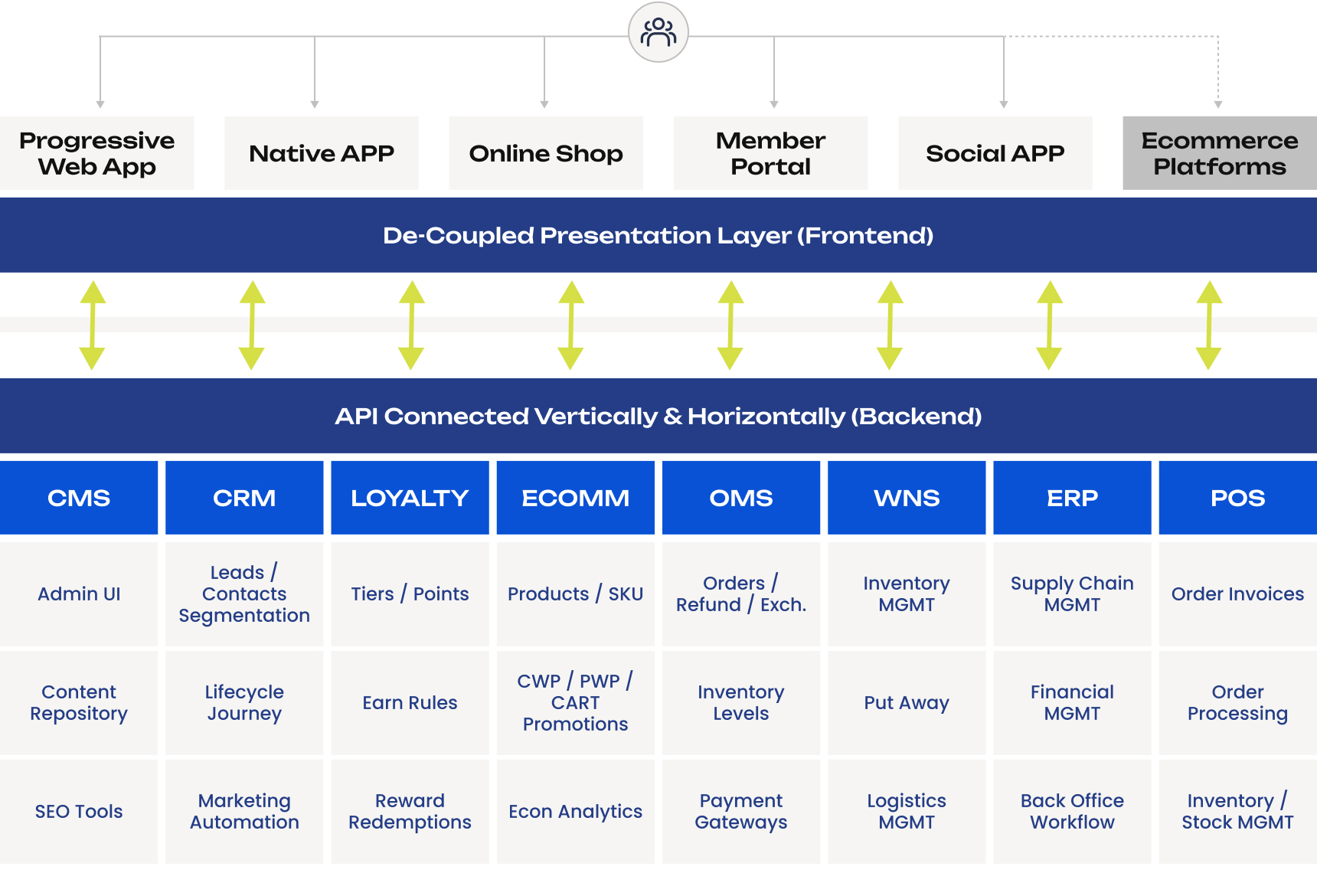Social distancing measures and lockdowns have resulted in a serious impact on businesses and consumer lifestyle. The pandemic has shifted consumer spending towards online e-commerce and this shift is not going away even after things get back to normal. Indeed, the crisis has led many bold companies to invest ambitiously into online channels and those with the right transformation strategy are likely to emerge as market leaders.
In this Master Report, XGATE proposes looking into three strategies to build a “headless commerce” architecture that will future-proof businesses as they dive into the new e-commerce reality.
As retail brands explore new online store strategies, it is imperative to understand the potential hurdles that e-commerce players may encounter when facing enhancing customer expectations.
Consumers are spoilt for choices, making the competition in digital online business fiercer than ever. Consumers can afford to be choosy in which brands receive their attention and then their business. Even companies with mature e-commerce capabilities today are facing challenging hurdles – capturing the right leads for conversions, retaining customers and rising customer acquisition cost. Hence, if the future of e-commerce is now, then companies must create a frictionless digital journey that comprises the following attributes:
1. A headless commerce architecture for rapid deployment
With paid media costs rising along with market competition, having a robust content strategy to attract organic traffic becomes vital. This strategy of content and commerce has been adopted by brands across social platforms such as Facebook Shops, Instagram Shopping, Taobao Live and Little Red Book, to name a few.
However, many retailers are adopting headless commerce architecture by decoupling the storefront from the backend e-commerce functionality. This approach allows brands to choose the best breed of architectural performance by integrating different systems such as content management, customer profile management, loyalty management, order management, warehouse management or even aPOS with an e-commerce platform. Here’s an overview diagram of how API-first headless commerce architecture is connected to support content distribution, loyalty marketing and commerce operations.

With headless commerce architecture, brands can launch e-commerce rapidly. A new online shop can be set up in days instead of months. In a competitive global market, timeto-market is always a key winning formula. Marketers’ ability to launch a campaign from weeks to days can determine the success or failure of a business. Additionally, brands can also share digital content rapidly and effectively. This truly opens up new possibilities to further distribute products, product videos, social blogs to different touchpoints – progressive web app, native app, member portal, social apps and any smart devices.
2. An omni-channel retail experience
Mobile technologies and social media adoption have changed the way consumers engage with brands. With the online and offline experience converging, brands need to adopt an omni-channel retail strategy as consumers will connect with a brand across multiple touchpoints throughout their buying journey. This means the product has to be everywhere when your customers browse, research or even buy.
Managing a multitude of selling channels online and offline is already a massive task requiring lots of resource planning, not to mention managing inventory across those channels. The implications for an out-of-stock situation or overstock position are costly from customer experience and operational expense perspectives. Hence, deploying commerce architecture with a well-integrated modular order management system (OMS) and warehouse management system (WMS) is essential in supporting e-commerce, ERPs and POS.
The omni-channel solution needs to ensure dataflow consistency across all platforms, consolidate data from all channels, reach customers at every possible touchpoint, and help manage inventory effectively. In fact, future approaches to commerce should incorporate user experience at every touchpoint as a critical solution design. Conversely, in comparison to traditional retail and online stores, the lack of a customer-first system architecture is the result of building solutions where individual channels were optimised continuously without considering the whole customer experience.
3. A loyalty strategy with personalised lifecycle marketing
The fierce competition for e-commerce has led to rising average acquisition cost for brands. From aggressive price-slashing during the Singles’ Day or Black Friday to the rising cost of influencer marketing campaigns, marketers are progressively changing their business strategies to invest more in building customer loyalty.
As brands implement loyalty marketing, one simple tactic is personalised communication. At various stages of a customer lifecycle, customers could be receiving welcome messages, birthday greetings, a reminder for points or membership expiry, pre-order invitations, private sales and even a small gift in shipped packages.
Creating a personalised shopping experience is more than the usual “people who bought X also purchased Y”. The backend systems have data on what a consumer has bought. Hence, it is important to use those data to power the personalisation engines on CMS, mobile apps and social channels. At different touchpoints, brands can reward loyal customers with small benefits. They can also highlight those extra benefits on the e-commerce page, such as free delivery after a certain spending amount or a personalised customer service contact for VIPs where they can reach out via telephone, SMS or where they can reach out via telephone, SMS or chat. Ultimately, the idea is to delight customers by delivering a consistent experience across touchpoints at critical moments in their journey.
The new e-commerce is here
One of the most compelling reasons for companies to embark into e-commerce is to avoid being caught up in a paradigm shift when retail business changes rapidly (especially during the COVID-19 pandemic). Today, different companies are in various stages of e-commerce maturity and some early adopters are already becoming mainstream online businesses in their industries – like Sephora in cosmetics, Suning.com in electronics or The Home Depot in home improvement products.
The future of commerce is already here as more people engage in new ways to explore product information, read reviews and place orders through various touchpoints. Today, new and mature online brands are meeting at across junction to evaluate a sustainable business strategy and choice of e-commerce platforms that offer true business agility. Therefore brands must make the switch to headless commerce architecture to support omni-channel (online and offline) retail marketing, create personalised experiences, retain customers with loyalty and remain competitive beyond the present.
Retail digital transformation from in-store to omnichannel
Omnichannel retail doesn’t require brands to Omnichannel retail doesn’t require brands to be present everywhere, just everywhere your customers are. Ultimately, the business goal is to create an integrated approach to commerce by providing a unified shopping experience across all channels or touchpoints.
Key business challenges:
• Weak retail sales – COVID-19 pandemic and lockdown have impacted retail sales, particularly luxury goods.
• The consumer behaviour shift – The slow economy has caused consumers to go for lower-priced premium brands that offer comparable quality without the high price tag. To address the challenges, D&G adopted an e-commerce strategy to bring the store experience to the consumers across touchpoints, while enhancing retail sales competence to provide customer service for online shoppers.
To deliver a unique seamless in-store and online shopping experience, they adopted headless commerce architecture as the foundation and developed mini-programmes around WeChat core functions. Three mini programmes were developed to serve different purposes:
1. E-commerce – for online sales activities
2. Member centre – for customers to check their transaction history, membership status and link to e-commerce
3. Clientelling – for retail sales to manage sales opportunities, connect customers toe-commerce and track sales performance. Additionally, D&G also developed a 360 degree virtual store with links to the online store.
The digital strategy has transformed retail operations to deliver omnichannel customer experience with high retention and sales conversion. At the retail stores, sales associates using clientelling were able to drive sales traffic into e-commerce and generated over 95%of new leads in a few months. The leads to sales conversions in the e-commerce mini programme have increased by over 13% and the brand was able to keep a healthy customer retention rate well above 40%. Indeed, D&G has successfully leveraged technology innovations to create a seamless customer experience and drive business profitability.
This post has been written by Xen Chia from XGATE under the Master Report series of Marketing Magazine, published in the January 2021 issue.




